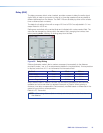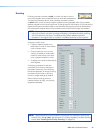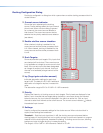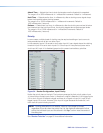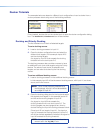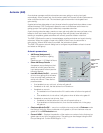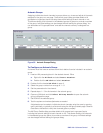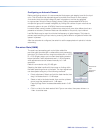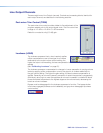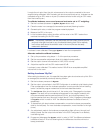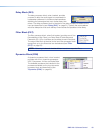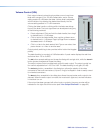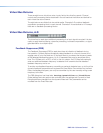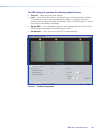
Pre-mixer Gain (GAIN)
The post-input processing gain control (also called the
pre-mixer gain) provides gain or attenuation post-processing
gain block. It includes a mono long-throw fader with a –100.0
to +12.0dB gain range, and a current tlevel setting readout
below the fader. Fader adjustments are in 1dB increments,
while adjustments can be entered manually to 0.1dB
resolution.
Default is unmuted at unity (0.0dB) gain.
Selecting the fader handle with the mouse or clicking within
the fader area brings focus to the fader. The input signal level
can be adjusted using any of the following methods:
• Direct adjustment. Select and hold the fader handle, then
drag it to desired level in 1.0dB steps.
• Select or tab to the fader handle, then use the up/down
arrow to set the desired level in 1dB steps.
Page Up/Page Down increases/decreases level in 5dB
steps.
• Click in or tab to the level readout field. Type a new value, then press <Enter> or
<Tab> to another area.
Configuring an Automix Channel
Before configuring automix, it is recommended that proper gain staging is set for the input
mics. This will ensure that adequate signal is provided for automix to work properly.
An automix block should be inserted for each microphone, and the mic assigned
to a group (see “Automix Groups Dialog” above). Setting a reasonable NOM for the
microphone group will increase intelligibility by limiting the number of open mics that are
allowed to gate on at once. A NOM of three is recommended.
In events where a small number of talkers may need priority over other talkers (such as a
presenter at a lectern) Chairman Mode can be enabled on the priority input channel.
Last Mic Mode may be used to minimize the frequency of gate changes. This helps to
prevent rapid switching of input mics by, ensuring that a talker is not gated off when their
speech is paused.
After the automixer is configured, be certain to set the appropriate mix-points to include
automixing.
Fader Handle
Input
Signal Level
Readout
DMP128 • Software Control 59



